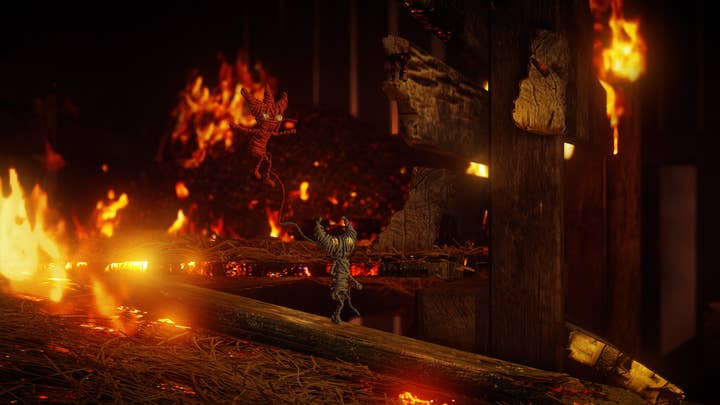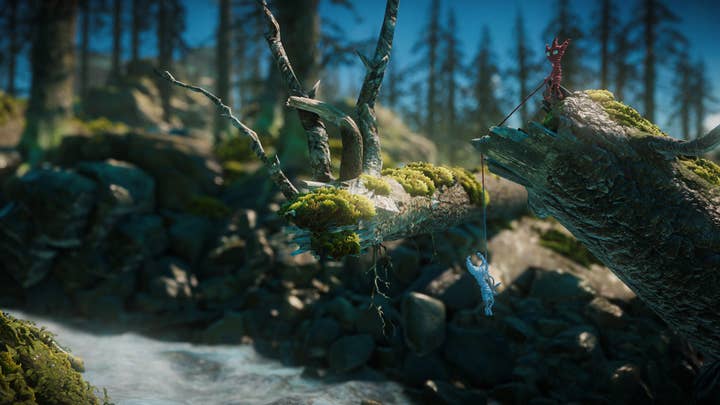Why Unravel Two is not on Nintendo Switch
Coldwood Interactive tells us how the console's simpler hardware would have delayed the surprise launch by six months
Electronic Arts' E3 2018 press conference was a very by-the-numbers affair, but by far the standout moment was the unexpected return of Unravel.
Not only was the delightful indie yarn now a co-operative platformer, it was also available the moment the publisher announced it - a welcome surprise that never fails to make an E3 reveal that little bit special.
Yet for anyone travelling to Los Angeles last week, the unexpected launch was tarnished ever so slightly by one disappointment: it wasn't available on Switch.
That's not to say all games should be released on Switch for the convenience of the travelling games professional, of course. But at first glance, this seemingly simple platformer would be a perfect fit for Nintendo's popular console - and developer Coldwood Interactive agrees.
"We had the same reaction when we saw the Switch for the first time," producer Michael Gill tells GamesIndustry.biz, reminding us that when work began on Unravel Two two years ago - shortly after the original released - the Switch didn't even exist yet.
He adds: "Even those controllers on the side are the same colours as the Yarnies - it's incredible. It's a machine made for Unravel Two. But we run at 60 frames per second, that's really important for us and we want to keep that framerate. To keep that on Switch, and to keep the graphical quality [would have been difficult]."

We're speaking to Gill and his colleague Jakob Marklund, lead programmer and co-founder of Coldwood Interactive, at the Xbox Games Showcase just two days after EA's Hollywood press conference. Marklund offers more details on the technical barriers that prevented the team from bringing their sequel to Switch.
"Although it may look like a simply platformer, some locations have around four million triangles on screen," he explains. "There are a lot of details, complex landscapes, all the vegetation and stuff. We can do it, but it will take some time.
"We're also using a heavily extended version of [Sony's] PhyreEngine, and we had to port it to Xbox One ourselves. It doesn't have support for Switch yet, so we would have to do that port and the engine work ourselves, and we're a really small team. We only have two engine programmers across the whole team, and they mostly work on updates for the game so we just didn't have time.
"We really wanted to be able to release this week, but if we had to do a Switch port it would have taken another half a year or so."
"Even those controllers on the side are the same colours as the Yarnies - it's incredible. It's a machine made for Unravel Two. But we run at 60 frames per second, and we want to keep that framerate"
Michael Gill, Coldwood Interactive
It's unusual for an indie title to push for an immediate launch - given the limited resources of these smaller teams, most take months if not years to make it into players' hands. But since the original Unravel proved to be so popular and Coldwood has been working on it for two years, they were keen to see if they could pull off that magic 'out now' E3 moment.
"It was a surprise for us as well that we could keep [the release plans] a secret this long," Gill admits. "I think the day before we announced, the co-op thing leaked but we managed it.
Marklund adds: "We think that was quite a fair way of doing it. Everyone knows the brand - it would have been a bit strange to do that for the first game. I think we lost momentum on the first game because we announced at E3 but didn't release until eight months later. This game was finished, so why not release it?"
Fortunately, the team was able to achieve that coveted 60fps they sought - but Gill tells us that even on Xbox One it was a struggle. Again, the conversation circles back to how deceptively simple the game seems to be, based purely on its mechanics and structure rather than its visuals, emphasising why it might not run on Nintendo's less powerful Switch.
"A lot of people say this should just be a simple port, because it's just a 2D platformer," says Marklund. "But the graphics are quite complicated, there's water simulation in a lot of areas and the yarn physics - although they're quite simple mechanics, it still has a lot of layers just to make it playable. There are a lot of physics to tweak all the time, and we have systems on top of those to make it feel good as well. We use all cores quite heavily on the bigger consoles."
Gill adds: "We get the feeling that people really want this on Switch, and we understand how they feel. But it feels a bit unfair, because we've put a lot of effort into this."

Initially, the disappointment at the lack of a Switch version was directed at Electronic Arts, presumed to be a further indication of the publisher's lacklustre support for the rapidly-selling Nintendo console.
"No, it's not EA pulling the brake," Gill interjects. "They really want to do games on Switch.
Marklund adds: "Don't blame EA, blame us."
The impact of the first Unravel cannot be understated. While it was a well-received and innovative title in its own right, it was also the game that inspired EA Originals: the publisher's efforts to bring indie titles to market without taking a cut of the profits. Since Unravel launched, we've received surreal adventure Fe, prison break thriller A Way Out and we're now expecting the introspective Sea of Solitude.
Coldwood Interactive is all too aware of its legacy and the effect it had on the publisher, and is pleased to see EA commit to its Originals initiative. And in return, the developer is keen to continue working with the FIFA publisher.
"It's really humbling to know we set the precedent for others to have the same opportunity that we have had," says Gill. "I feel like we have the best of both worlds: we have the security of having a big publisher supporting us, but at the same time we have the creative freedom to do what we want. Unravel Two is basically us looking at Unravel and saying, 'Okay, what game do we really want this to be?', using all the things we learned from the first one.
"We're really happy how it's been with EA. They've been really brilliant for us."








